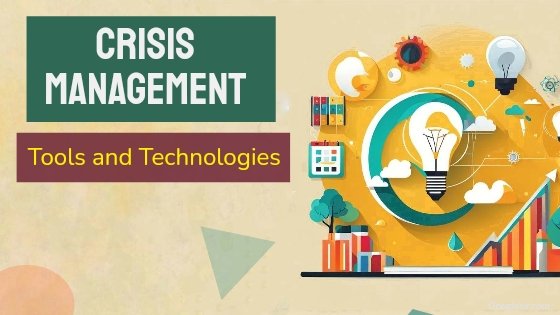In an increasingly interconnected world, crisis management has become an indispensable facet of modern governance, corporate strategy, and disaster response. From natural disasters to cyberattacks, pandemics to political upheavals, crises of varying magnitude can strike at any moment, disrupting normalcy and posing multifaceted challenges to governments, organizations, and communities alike.

To effectively navigate these turbulent waters, stakeholders rely on an arsenal of tools and technologies, each designed to provide a deeper understanding of the crisis, facilitate swift decision-making, and coordinate responses with precision.
Crisis management is not just about reacting to crises; it also involves proactive planning and preparation to mitigate potential risks and minimize the impact of unforeseen events.
Effective crisis management includes activities like risk assessment, developing crisis communication plans, conducting crisis simulations, and using advanced technologies to improve preparedness and response.
What are the Tools and Technologies for Crisis Management?
The following are the crisis management tools and technologies.
1. Geographic Information Systems (GIS)
Geographic Information Systems (GIS) are powerful tools for crisis management, offering spatial data analysis and visualization capabilities. GIS platforms allow stakeholders to map out crisis areas, analyze risk factors, and allocate resources strategically.
During natural disasters like hurricanes or wildfires, GIS assists in monitoring real-time conditions, tracking the movement of the crisis, and aiding evacuation planning.
Additionally, it enables the integration of various data sources, such as weather forecasts, demographic information, and infrastructure maps, providing a holistic view of the crisis situation.
2. Big Data Analytics
The proliferation of data in the digital age has given rise to big data analytics as a crucial component of crisis management.
This technology harnesses the vast amount of data generated during a crisis, including social media posts, sensor readings, and communication logs, to extract actionable insights.
Machine learning algorithms can identify patterns, sentiment trends, and anomalies, helping decision-makers assess the public mood, predict crisis developments, and allocate resources accordingly. Big data analytics also enables the creation of predictive models for crisis scenarios, aiding in proactive planning and response.
3. Emergency Notification Systems
During a crisis, timely and accurate communication is paramount. Emergency notification systems, often integrated with GIS, enable authorities to rapidly disseminate critical information to the public.
These systems can send alerts via text messages, emails, phone calls, and social media, ensuring that residents and stakeholders are informed and can take appropriate actions.
Moreover, some systems support two-way communication, allowing affected individuals to report their status or request assistance, enhancing situational awareness.
4. Social Media Monitoring Tools
Social media has emerged as a powerful communication channel during crises, providing real-time updates, eyewitness accounts, and a platform for public discourse.
Social media monitoring tools, powered by natural language processing and sentiment analysis, help organizations track relevant conversations, identify emerging issues, and gauge public sentiment.
By monitoring hashtags, geotags, and keywords, authorities can respond to rumors, dispel misinformation, and engage with the community effectively.
5. Incident Management Systems
Incident management systems (IMS) are comprehensive platforms that streamline crisis response and coordination efforts. These systems centralize information from various sources, including emergency services, government agencies, and non-profit organizations, creating a unified situational picture.
IMS tools facilitate task assignment, resource allocation, and progress tracking, ensuring that all stakeholders are on the same page and that resources are optimized.
In addition, they often include real-time communication features, enabling instant collaboration among response teams.
6. Satellite Imagery
Satellite imagery plays a vital role in crisis management, particularly in assessing the extent of damage caused by natural disasters and monitoring ongoing environmental changes.
High-resolution satellite images can provide valuable information for damage assessment, infrastructure monitoring, and disaster impact analysis.
Advanced satellite technology, such as synthetic aperture radar (SAR), can even penetrate cloud cover and provide imagery during adverse weather conditions, ensuring uninterrupted monitoring capabilities.
7. Unmanned Aerial Vehicles (UAVs) or Drones
Unmanned Aerial Vehicles (UAVs) or drones are versatile tools that have found numerous applications in crisis management.
Equipped with cameras, sensors, and sometimes even thermal imaging capabilities, drones can quickly and safely survey disaster-affected areas. They are instrumental in locating survivors, assessing structural damage, and guiding search and rescue efforts.
In addition, drones can provide real-time video feeds to decision-makers, allowing them to make informed decisions based on up-to-the-minute information.
8. Crisis Simulation Software
Crisis simulation software enables stakeholders to create and run realistic crisis scenarios for training and preparedness purposes.

These simulations mimic various crisis types, such as natural disasters, cyberattacks, or public health emergencies, allowing organizations to test their response plans and refine their strategies.
Simulation software incorporates factors like geography, population density, and resource availability, providing a dynamic environment for decision-makers to hone their crisis management skills.
9. Predictive Modeling for Disease Outbreaks
The outbreak of infectious diseases, as exemplified by the COVID-19 pandemic, has underscored the importance of predictive modeling in crisis management.
Epidemiological models, fueled by data on disease spread, population dynamics, and healthcare capacity, can forecast disease trajectories and guide public health interventions.
These models assist in resource allocation, vaccine distribution, and containment strategies, ultimately saving lives by enabling data-driven decision-making.
10. Cybersecurity Tools
As the digital landscape becomes increasingly intertwined with critical infrastructure and essential services, cybersecurity tools are essential for crisis management.
Threat detection and prevention systems continuously monitor networks and systems for unusual activities and vulnerabilities.
In the event of a cyberattack, these tools can respond by isolating affected systems, blocking malicious traffic, and initiating incident response protocols to mitigate the damage.
11. Secure Communication Platforms
During crises, secure communication platforms ensure the confidentiality and integrity of sensitive information.
End-to-end encryption, secure video conferencing, and encrypted messaging apps protect sensitive conversations from interception and tampering.
These platforms are vital for coordinating responses, sharing classified information, and safeguarding critical infrastructure from cyber threats.
12. Mobile Field Hospitals
Mobile field hospitals are deployable medical facilities equipped with state-of-the-art technology to provide emergency medical care during crises.

These units can be rapidly transported to disaster-stricken areas, ensuring that medical assistance is available when and where it is needed most.
Mobile hospitals are equipped with diagnostic equipment, operating theaters, and patient management systems, enabling medical teams to treat a wide range of injuries and illnesses.
13. Water Purification Systems
Access to clean water is often compromised during crises, be it due to natural disasters or infrastructure damage. Water purification systems, including portable devices and large-scale treatment plants, play a pivotal role in ensuring a safe water supply.
Advanced filtration and disinfection technologies remove contaminants and pathogens, safeguarding public health in the aftermath of disasters.
Conclusion:
Crisis management is a multifaceted endeavor that demands a wide array of tools and technologies to address the complex challenges posed by crises of all types and magnitudes.
From understanding the crisis landscape through GIS and big data analytics to effective communication and coordination via notification systems and social media monitoring tools, the modern crisis manager’s toolkit is diverse and dynamic. Remote sensing and environmental monitoring tools, such as satellites and drones, provide critical situational awareness, while predictive modeling and simulation software allow organizations to prepare for the unpredictable.
In an increasingly digital world, cybersecurity tools and secure communication platforms protect critical infrastructure and sensitive information from cyber threats. Meanwhile, humanitarian technologies like mobile field hospitals and water purification systems ensure that life-saving services are readily available to those in need during crises.
As the world continues to evolve and new challenges emerge, the tools and technologies of crisis management will undoubtedly continue to advance. By harnessing the power of innovation and integrating these tools into comprehensive crisis management strategies, governments, organizations, and communities can navigate the ever-changing landscape of crisis with precision and resilience. In doing so, they can mitigate the impact of crises, protect lives and assets, and build a more secure and resilient future for all.

